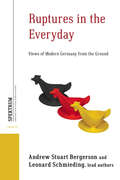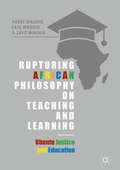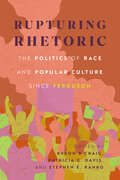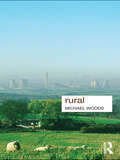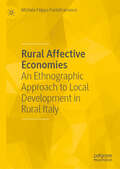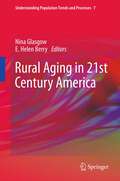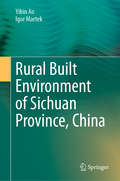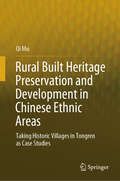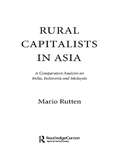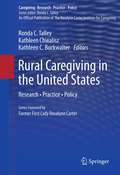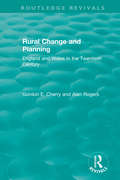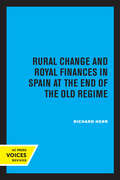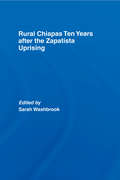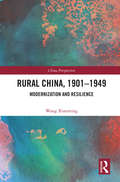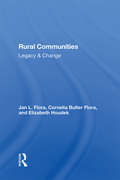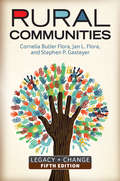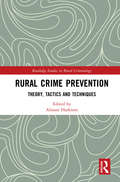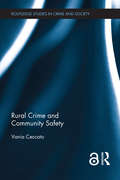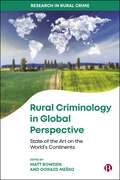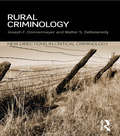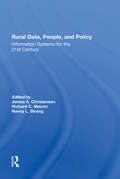- Table View
- List View
Ruptures in the Everyday: Views of Modern Germany from the Ground (Spektrum: Publications of the German Studies Association #15)
by Andrew Stuart Bergerson Leonard Schmieding Atg26During the twentieth century, Germans experienced a long series of major and often violent disruptions in their everyday lives. Such chronic instability and precipitous change made it difficult for them to make sense of their lives as coherent stories—and for scholars to reconstruct them in retrospect. Ruptures in the Everyday brings together an international team of twenty-six researchers from across German studies to craft such a narrative. This collectively authored work of integrative scholarship investigates Alltag through the lens of fragmentary anecdotes from everyday life in modern Germany. Across ten intellectually adventurous chapters, this book explores the self, society, families, objects, institutions, policies, violence, and authority in modern Germany neither from a top-down nor bottom-up perspective, but focused squarely on everyday dynamics at work “on the ground.”
Rupturing African Philosophy on Teaching and Learning: Ubuntu Justice And Education
by Yusef Waghid Faiq Waghid Zayd WaghidThis book examines African philosophy of education and the enactment of ubuntu justice through a massive open online course on Teaching for Change. The authors argue that such pedagogic encounters have the potential to stimulate just and democratic human relations: encounters that are critical, deliberate, reflective and compassionate could enable just and democratic human relations to flourish, thus inducing decolonisation and decoloniality. Exploring arguments for imaginative and tolerant pedagogic encounters that could help cultivate an African university where educators and students can engender morally and politically responsible pedagogical actions, the authors offer pathways for thinking more imaginatively about higher education in a globalised African context. This work will be of value for researchers and students of philosophy of education, higher education and democratic citizenship education.
Rupturing Rhetoric: The Politics of Race and Popular Culture since Ferguson (Race, Rhetoric, and Media Series)
by Byron B Craig, Patricia G. Davis, and Stephen E. RahkoContributions by Maksim Bugrov, Byron B Craig, Patricia G. Davis, Peter Ehrenhaus, Whitney Gent, Christopher Gilbert, Oscar Giner, J. Scott Jordan, Euni Kim, Melanie Loehwing, Jaclyn S. Olson, A. Susan Owen, Stephen E. Rahko, Nick J. Sciullo, Arthur D. Soto-Vásquez, and Erika M. ThomasThe events surrounding the 2014 killing of Michael Brown in Ferguson, Missouri, marked a watershed moment in US history. Though this instance of police brutality represented only the latest amid decades of similar unjust patterns, it came to symbolize state complicity in the deployment of violence to maintain racial order. Rupturing Rhetoric: The Politics of Race and Popular Culture since Ferguson responds to the racial rhetoric of American popular culture in the years since Brown's death. Through close readings of popular media produced during the late Obama and Trump eras, this volume details the influence of historical and contemporary representations of race on public discourse in America.Using Brown’s death and the ensuing protests as a focal point, contributors argue that Ferguson marks the rupture of America’s postracial fantasy. An ideology premised on colorblindness, the notion of the “postracial” suggests that the United States has largely achieved racial equality and that race is no longer a central organizing category in American society. Postracialism is partly responsible for ahistorical, romanticized narratives of slavery, Jim Crow segregation, and American exceptionalism. The legitimacy of this fantasy, the editors contend, was the first casualty of the tanks, tear gas, and rubber bullets wielded against protesters during the summer of 2014. From these protests emerged a new political narrative organized around #BlackLivesMatter, which directly challenged the fantasy of a postracial American society.Essays in Rupturing Rhetoric cover such texts as Fresh Off the Boat; Hamilton; Green Book; NPR’s American Anthem; Lovecraft Country; Disney remakes of Dumbo, The Lion King, and Lady and the Tramp; BlacKkKlansman; Crazy Rich Asians; The Hateful Eight; and Fences. As a unified body of work, the collection interrogates the ways contemporary media in American popular culture respond to and subvert the postracial fantasy underlying the politics of our time.
Rural
by Michael WoodsThe division of ‘rural’ and ‘urban’ is one of the oldest ideas in Geography and is deeply engrained in our culture. Throughout history, the rural has been attributed with many meanings: as a source of food and energy; as a pristine wilderness, or as a bucolic idyll; as a playground, or a place of escape; as a fragile space of nature, in need of protection; and as a primitive place, in need of modernization. But is the idea of the rural still relevant today? Rural provides an advanced introduction to the study of rural places and processes in Geography and related disciplines. Drawing extensively on the latest research in rural geography, this book explores the diverse meanings that have been attached to the rural, examines how ideas of the rural have been produced and reproduced, and investigates the influence of different ideas in shaping the social and economic structure of rural localities and the everyday lives of people who live, work or play in rural areas. This authoritative book contains case studies drawn from both the developed and developing world to introduce and illustrate conceptual ideas and approaches, as well as suggested further reading. Written in an engaging and lively style, Rural challenges the reader to think differently about the rural.
Rural Affective Economies: An Ethnographic Approach to Local Development in Rural Italy
by Michele Filippo FontefrancescoThis book delves into the development trajectories of rural Europe, with a specific focus on Italy. The book addresses the key challenges rural communities face and explores the potential for grassroots development. The concept of affective economy is central to the book, which is introduced and utilized to analyze these dynamics. The book assesses local food heritage and agrifood chains to showcase how these elements can serve as pillars for sustainable local development. It provides tools and methodologies for identifying and documenting food heritage, offering practical insights for public and private stakeholders interested in fostering local economic growth, and shows how emotional and social bonds within communities can drive sustainable growth. This book is a must-read for academics and practitioners passionate about sustainable development who want to envision concrete strategies for rural development.
Rural Aging in 21st Century America
by J. V. Edmund Nina Glasgow E. Helen BerryThis book investigates sociological, demographic and geographic aspects of aging in rural and nonmetropolitan areas of the United States. Population aging is one of the most important trends of the 20th and 21st centuries, and it is occurring worldwide, especially in more developed countries such as the United States. Population aging is more rapid in rural than urban areas of the U.S. In 2010, 15 percent of the nonmetropolitan compared to 12 percent of the metropolitan population were 65 years of age and older. By definition rural communities have smaller sized populations, and more limited healthcare, transportation and other aging-relevant services than do urban areas. It is thus especially important to study and understand aging in rural environments. Rural Aging in 21st Century America contributes evidence-based, policy-relevant information on rural aging in the U.S. A primary objective of the book is to improve understanding of what makes the experience of rural aging different from aging in urban areas and to increase understanding of the aged change the nature of rural places. The book addresses unique features of rural aging across economic, racial/ethnic, migration and other structures and patterns, all with a focus on debunking myths about rural aging and to emphasize opportunities and challenges that rural places and older people experience.
Rural Arab Demography and Early Jewish Settlement in Palestine: Distribution and Population Density During the Late Ottoman and Early Mandate Periods
by David GrossmanThis volume explores the distribution of the rural population in Palestine from the late Ottoman period (1870-1917) to the British Mandate period (1917-1948). The book focuses on demography, specifically migrations, population size, density, growth, and the pattern of distribution in rural Palestine before the inception of Jewish settlement (1882). Grossman traces little-known Muslim ethnic groups who settled in Palestine's rural areas, primarily Egyptians, but also Algerians, Bosnians, and Circassians. The author argues that the Arab population in the zones occupied by Jews after 1882 was about one-third that of the Arab core areas; in the period studied, the decline in per-capita rural Arab farmland was mainly due to overall population growth, not displacement of Arabs; economic development suffered largely because of violent disturbances and natural disasters; the pattern of growth of Egyptian and other Muslim groups was similar to that of the Jews. The main conclusions of this study note that the size of the rural Arab population in the zones occupied by Jews after 1882 was about one-tenth of that which occupied the Arab core zones; most Egyptian settlement areas coincided with those of the Jewish zones; between 1870 and 1945, the decline of Arab farmland was mainly due to Arab population growth rather than Jewish land acquisitions; and most migrants (Jewish and Muslim) settlement zones were leftovers characterized by some form of resource disability.
Rural Built Environment of Sichuan Province, China
by Yibin Ao Igor MartekMajor changes are taking place in the Chinese countryside as China rushes to modernizes and urbanizes its rural fabric. The transformation is improving the quality of life of rural inhabitants, but also brings about challenges as people strive to adjust. This book systematically examines the impact of change on the daily lives and activities of the residents of Sichuan Province, in China’s South-west. It examines the themes of infrastructure, transport modes and preferences, sanitation, water conservation, earthquake and flood disaster preparedness, and the impact these have on villager behavior and quality of life. This book is an essential reference guide for graduate students and practitioners in the fields of rural planning, renewal, and construction.
Rural Built Heritage Preservation and Development in Chinese Ethnic Areas: Taking Historic Villages in Tongren as Case Studies
by Qi MuThis book discusses how rural built heritage preservation and development in the Chinese ethnic area in Tongren, China has been strongly addressed by the labeling, planning, project-making, follow-up management characterized by different patterns of stakeholders. Moreover, the rural built heritage preservation and development is an instrument of power that has been incorporated into the municipal, county and lower-level planning settings, portraying an overall top-down government-led feature. An intentional laddered development for the government’s overall strategy of resource allocation and spatial reorganization has been identified. Different patterns of stakeholders are identified. This book discusses how different roles played by stakeholders tend to be inseparable and often overlapped thus forming ambiguous and difficulty controllable dynamics in shaping the rural built environment. In conclusion, insights have been provided based on the debates of AHD and positioning rural built heritage preservation within the public governance.
Rural Capitalists in Asia: A Comparative Analysis on India, Indonesia and Malaysia (Nias Monographs #No. 88)
by Mario RuttenThis is a comparative study of small capitalists and rural industrialists in three Asian countries. Studies on the entrepreneurial class in South Asia tend to focus on the structural aspects of entrepreneurial behaviour, while studies on this class in Southeast Asia tend to focus on cultural aspects of their behaviour. In fact, this book points to striking similarities between Indian, overseas Chinese and Muslim businessmen in Asia, similarities usually hidden under variations in analytical approaches. Although this study emphasizes similarities within Asia, it does not support the view of a specific Asian business pattern different to the rise of non-Asian, especially European, entrepreneurs. The findings are of major interest not just within the fields of anthropology and entrepreneurship, but to all scholars working on South or Southeast Asia, who will find much of interest in the author's observations of variable research results between the two regions.
Rural Caregiving in the United States
by Ronda C. Talley Kathleen Chwalisz Kathleen C. BuckwalterCaregivers living in rural areas face daunting obstacles. In addition to the isolation and anxiety that many caregivers across the country experience, rural caregivers must also cope with limited access to uncoordinated resources and severe shortages of trained professionals. Although many research, policy, and practice upgrades have been made in response to caregivers' general concerns, the specific problems facing the rural caregiver have been less frequently addressed. Focusing on what is known as well as what is needed - and zeroing in on major subgroups within this diverse population - Rural Caregiving in the United States replaces misconceptions of the nonurban experience with real-life issues, findings, and solutions. For example, this pioneering volume: Covers a broad range of issues unique to rural caregiving, including research, education/training, policy, and practice.Identifies specific needs related to education, training, and support for rural caregivers.Examines both the positive and negative effects of rural living on caregivers as well as patients.Discusses the importance of in-home care in lieu of scarcer forms of for-profit care (e.g., hospitals).Addresses not only discrepancies between rural and urban health care systems but racial and ethnic disparities within rural health care.Explores the advantages of using information technology to address rural health care limitations. Rural Caregiving in the United States offers uniquely knowledgeable perspectives to researchers, practitioners, and graduate students in the caregiving fields, including psychology, social work, nursing, gerontology and geriatrics, medicine, public health, public policy, and educational policy.
Rural Change and Planning: England and Wales in the Twentieth Century (Routledge Revivals)
by Alan Rogers Gordon E. CherryOriginally published in 1996 Rural Change and Planning describes the turbulent changes that have occurred in rural England and Wales since the outbreak of the First World War. The book describes the changes from an agriculturally-dominated countryside to one which has had to increasingly adapt to urban pressures. Looking at the changes chronologically, the book provides an integrated history of rural planning in the twentieth century and the developments which have taken place within the State, which has facilitated those changes. The book looks at the social and economic impacts of two world wars on agricultural communities, and the pressures of industry, new settlements and the effects of recreation on rural landscapes.
Rural Change and Royal Finances in Spain at the End of the Old Regime
by Richard HerrThis title is part of UC Press's Voices Revived program, which commemorates University of California Press’s mission to seek out and cultivate the brightest minds and give them voice, reach, and impact. Drawing on a backlist dating to 1893, Voices Revived makes high-quality, peer-reviewed scholarship accessible once again using print-on-demand technology. This title was originally published in 1989.
Rural Change in Australia: Population, Economy, Environment (Perspectives On Rural Policy And Planning Ser.)
by John ConnellNew twenty-first century economic, social and environmental changes have challenged and reshaped rural Australia. They range from ageing populations, youth out-migration, immigration policies (that seek to place skilled migrants in rural Australia), tree changers, agricultural restructuring and new relationships with indigenous populations. Challenges also exist around the 'patchwork economy' and the wealth that the mining boom offers some areas, while threatening regional economic decline in others. Rural Australia is increasingly not simply a place of production of agriculture and minerals but an idea that individuals seek and are encouraged to consume. The socio-economic implications of drought, water rights and changing farming practices, have prefaced new social, cultural and economic reforms. This book provides a contemporary perspective on rapidly evolving population, economic and environmental changes in 'rural and regional Australia', itself a significant concept. Bringing together a range of empirical studies, the book builds on established rural studies themes such as population change, economic restructuring and globalisation in agriculture but links such changes to environmental change, culture, class, gender, and ethnic diversity. Presenting original and in-depth interventions on these issues and their intersections, this book assembles the best of contemporary research on rural Australia.
Rural Chiapas Ten Years after the Zapatista Uprising
by Sarah WashbrookConsidered the most significant recent agrarian movement in Mexico, the 1994 EZLN uprising by the indigenous peasantry of Chiapas attracted world attention. Timed to coincide with the signing of the NAFTA agreement, the Zapatista Army of National Liberation reasserted the value of indigenous culture and opposed the spread of neo-liberalism associated with globalization. The essays in this collection examine the background to the 1994 uprising, together with the reasons for this, and also the developments in Chiapas and Mexico in the years since. Among the issues covered are the history of land reform in the region, the role of peasant and religious organizations in constructing a new politics of identity, the participation in the rebellion of indigenous women and changing gender relations, plus the impact of the Zapatistas on Mexican democracy. The international group of scholars contributing to the volume include Sarah Washbrook, George and Jane Collier, Antonio García de León, Daniel Villafuerte Solís, Gemma van der Haar, Mercedes Olivera, Marco Estrada Saavedra, Heidi Moksnes, Neil Harvey, and Tom Brass.This book was previously published as a special issue of The Journal of Peasant Studies.
Rural China, 1901–1949: Modernization and Resilience (China Perspectives)
by Wang XianmingHighlighting the interwoven relationship between Chinese rural society and larger historical forces, this book charts the evolution of China’s rural society from 1901 to 1949, concentrating on the major changes of this period and the scenarios developed to modernize rural society during the half century leading up to the Revolution. The modern history of rural China is one of sweeping institutional and structural transformation across many dimensions. As the first half of the twentieth century unfolded, against a backdrop of turbulent changes across a country that underwent industrialization, urbanization and modernization, China's agriculture, rural population and rural communities encountered many crises, but also showed remarkable resilience and capacity for adaptation and reform. In each of the six chapters, the author delves into one aspect or examines one period of this massive transformation, and identifies the social, economic, political and cultural significance of these tumultuous processes at work. The book will appeal to both scholars and general readers interested in modern Chinese history and the transformation of rural China.
Rural Communities
by Cornelia Butler Flora Jan L. FloraRural Communities: Legacy and Changeexamines the diversity of rural America: its unique communities, histories, and social issues. It also considers how rural communities use their increasing connectedness to creatively address modern challenges in the face of increasing globalization and climate change. Focusing on various capitals in rural areas-natural, cultural, human, social, political, financial, and built-this book provides students with an essential framework for understanding rural society based on the concepts of social science. As the only true core text available for rural sociology courses,Rural Communitiescovers vital issues such as: racial and cultural diversity in rural areas; globalization and increasing tensions over international immigration; the impact of the wars in Iraq and Afghanistan; the central role of communities in organizing a sustainable future; and building community in the context of ubiquitous change. Chapter opening vignettes present real people and communities, illustrating the application of concepts. The fourth edition ofRural Communitiesis updated with 2010 Census data and features new coverage of local food movements, climate change, the impacts of the global financial crisis, and updates on immigration as it relates to rural societies.
Rural Communities
by Cornelia Butler Flora Jan L FloraRural Communities: Legacy and Change examines the diversity of rural America: its unique communities, histories, and social issues. It also considers how rural communities use their increasing connectedness to creatively address modern challenges in the face of increasing globalization and climate change. Focusing on various capitals in rural areas--natural, cultural, human, social, political, financial, and built--this book provides students with an essential framework for understanding rural society based on the concepts of social science. The fourth edition of Rural Communities covers vital issues such as: racial and cultural diversity in rural areas; globalization and increasing tensions over international immigration; the impact of the wars in Iraq and Afghanistan; the central role of communities in organizing a sustainable future; and building community in the context of ubiquitous change. Chapter opening vignettes present real people and communities, illustrating the application of concepts. Updated with 2010 Census data, the fourth edition features new coverage of local food movements, climate change, the impacts of the global financial crisis, and updates on immigration as it relates to rural societies.
Rural Communities Study Guide: Legacy + Change
by Jan L. Flora Mark Weinberg Cornelia Flora Elizabeth HoudekThis book examines the process of rural community development and transition—exploring the ways in which history, culture, and policies limit change as well as the extent to which local community resources can mobilize to support efforts for community change.
Rural Communities: Legacy + Change (Advances In Agroecology Ser.)
by Cornelia Butler FloraCommunities in rural America are a complex mixture of peoples and cultures, ranging from miners who have been laid off in West Virginia, to Laotian immigrants relocating in Kansas to work at a beef processing plant, to entrepreneurs drawing up plans for a world-class ski resort in California's Sierra Nevada. Rural Communities: Legacy and Change uses its unique Community Capitals framework to examine how America's diverse rural communities use their various capitals?natural, cultural, human, social, political, financial, and built?to address the modern challenges that face them.Each chapter opens with a case study of a community facing a particular challenge, and is followed by a comprehensive discussion of sociological concepts to be applied to understanding the case. This narrative, topical approach makes the book accessible and engaging for undergraduate students, while its integrative approach provides them with a framework for understanding rural society based on the concepts and explanations of social scienceThis fifth edition is updated throughout with 2013 census data and features new and expanded coverage of health and health care, food systems and alternatives, the effects of neoliberalism and globalization on rural communities, as well as an expanded resource and activity section at the end of each chapter.
Rural Crime Prevention: Theory, Tactics and Techniques (Routledge Studies in Rural Criminology)
by Alistair HarknessRural crime has long been overlooked in the field of crime prevention. Sustained academic interrogation is necessary, therefore, to reduce the extensive economic and social costs of rural crime as well as to challenge some of the myths regarding the prevention of rural crime. Rural Crime Prevention: Theory, Tactics and Techniques critically analyses, challenges, considers and assesses a suite of crime prevention initiatives across an array of international contexts. This book recognises the diversity and distinct features of rural places and the ways that these elements impact on rates, experiences and responses. Crucially, Rural Crime Prevention also incorporates non-academic voices which are embedded throughout the book, linking theory and scholarship with practice. Proactive responses to rural offending based on sound evidence can serve to facilitate feelings of safety and security throughout communities, enhance individual wellbeing and alleviate pressure on the overburdened and typically under-resourced formal elements of the criminal justice system. This book provides an opportunity to focus on the prevention of crime in regional, rural and remote parts of the globe. An accessible and compelling read, this book will appeal to students and scholars of criminology, policing, sociology and practitioners interested in learning about the best-practice international approaches to rural crime prevention in the twenty-first century.
Rural Crime and Community Safety (Routledge Studies in Crime and Society)
by Vania A CeccatoCrime is often perceived as an urban issue rather than a problem that occurs in rural areas, but how far is this view tenable? This book explores the relationship between crime and community in rural areas and addresses the notion of safety as part of the community dynamics in such areas. Rural Crime and Community Safety makes a significant contribution to crime science and integrates a range of theories to understand patterns of crime and perceived safety in rural contexts. Based on a wealth of original research, Ceccato combines spatial methods with qualitative analysis to examine, in detail, farm and wildlife crime, youth related crimes and gendered violence in rural settings. Making the most of the expanding field of Criminology and of the growing professional inquiry into crime and crime prevention in rural areas; rural development; and the social sustainability of rural areas, this book builds a bridge by connecting Criminology and Human Geography. This book will be suitable for academics, students and practitioners in the fields of criminology, community safety, rural studies, rural development and gender studies.
Rural Criminology in Global Perspective: State of the Art on the World's Continents (Research in Rural Crime)
by Matt Bowden and Gorazd MeškoThis timely collection crosses international boundaries to highlight criminological issues with a rural focus. Using a variety of different perspectives, the contributors offer lessons from research on rural crime, justice and security from the seven continents with a macroscopic perspective on issues of international concern. The book identifies the global context in which rural crime takes place, presenting insights on crime prevention, safety and security to students, researchers, policymakers and practitioners. Chapters 2 and 8 available open access digitally under CC-BY-NC-ND licence.
Rural Criminology: Rural Criminology (New Directions in Critical Criminology)
by Joseph F Donnermeyer Walter DeKeseredyRural crime is a fast growing area of interest among scholars in criminology. From studies of agricultural crime in Australia, to violence against women in Appalachia America, to poaching in Uganda, to land theft in Brazil -- the criminology community has come to recognize that crime manifests itself in rural localities in ways that both conform to and challenge conventional theory and research. For the first time, Rural Criminology brings together contemporary research and conceptual considerations to synthesize rural crime studies from a critical perspective. This book dispels four rural crime myths, challenging conventional criminological theories about crime in general. It also examines both the historical development of rural crime scholarship, recent research and conceptual developments. The third chapter recreates the critical in the rural criminology literature through discussions of three important topics: community characteristics and rural crime, drug use, production and trafficking in the rural context, and agricultural crime. Never before has rural crime been examined comprehensively, using any kind of theoretical approach, whether critical or otherwise. Rural Criminology does both, pulling together in one short volume the diverse array of empirical research under the theoretical umbrella of a critical perspective. This book will be of interest to those studying or researching in the fields of rural crime, critical criminology and sociology.
Rural Data, People, And Policy: Information Systems For The 21st Century
by Lis M. Maurer Nancy Strang James A ChristensonThis volume paints a critical view of the state of rural data systems in America with a collection of contributions leading scholars in the social sciences arena. It places an important wake-up call social scientists engaged in rural research, alerting them to the problems of existing data systems.
